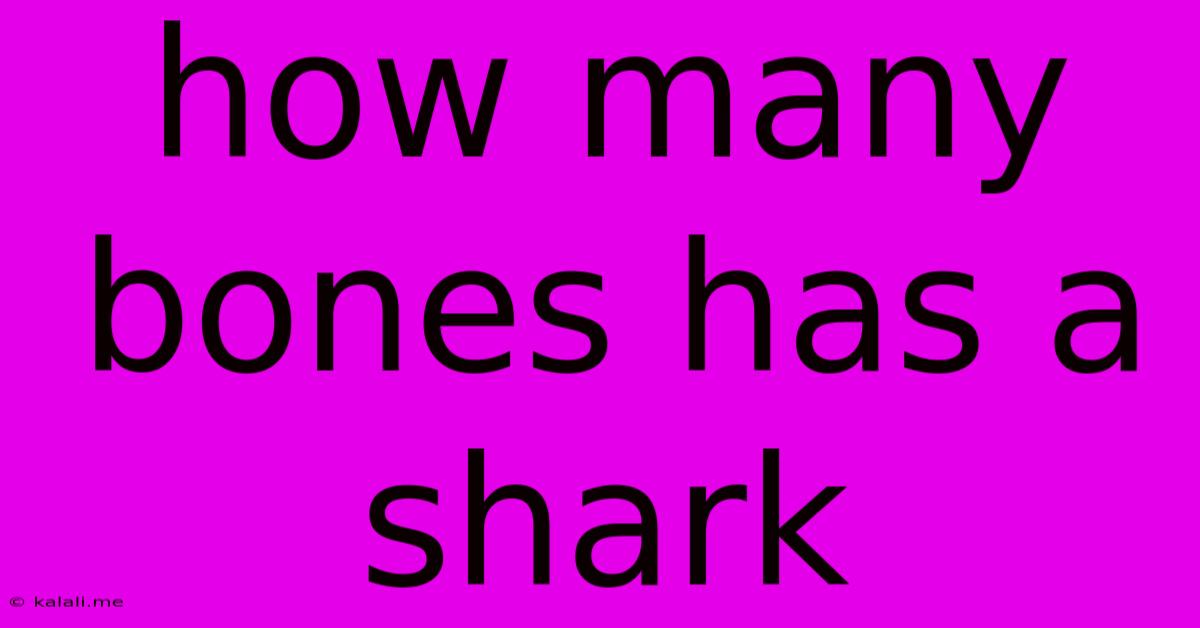How Many Bones Has A Shark
Kalali
May 08, 2025 · 3 min read

Table of Contents
How Many Bones Does a Shark Have? The Surprising Answer
Meta Description: Discover the surprising truth about shark skeletons! Learn why sharks don't have bones like humans do and what makes their skeletal structure unique. This comprehensive guide explores shark anatomy and physiology.
Sharks are fascinating creatures of the ocean, often feared for their sharp teeth and powerful jaws. But beyond their intimidating appearance lies a unique anatomical feature that sets them apart from most other vertebrates: they don't have bones! This leads us to the question: how many bones does a shark have? The answer is surprisingly simple: zero.
Instead of a bony skeleton, sharks possess a cartilaginous skeleton. Cartilage is a flexible, strong connective tissue that provides support and structure. This is a crucial adaptation that contributes to their agility and effectiveness as predators.
Understanding Cartilage and its Advantages for Sharks
Cartilage is lighter than bone, granting sharks greater maneuverability in the water. This is particularly important for swift movements, quick turns, and efficient hunting. The flexibility of cartilage also helps to absorb shocks and impacts, protecting the shark from injury during high-speed chases and aggressive feeding. The lightweight nature also contributes to their buoyancy, reducing the energy expenditure required to stay afloat.
This skeletal structure is a key element in their evolutionary success, allowing them to thrive in a variety of marine environments, from shallow coastal waters to the deep ocean. The flexible cartilage allows for a wider range of motion compared to bony skeletons, enhancing their predatory prowess.
The Composition of a Shark's Skeleton
While sharks lack bones in the traditional sense, their skeletons are far from simple. The cartilaginous skeleton comprises various components, including:
- Cranium: The cartilaginous skull protects the shark's brain.
- Vertebral column: A flexible series of cartilaginous vertebrae provides support for the body and allows for movement.
- Jaws: The powerful jaws, responsible for capturing and consuming prey, are also made of cartilage.
- Fin rays: These provide support and structure to the fins, crucial for swimming and maneuverability. These are often calcified, meaning they have some mineral deposits, but still remain fundamentally cartilaginous.
The cartilage itself is composed primarily of collagen fibers, providing strength and flexibility. In some species, calcium salts are deposited within the cartilage, adding to its strength and rigidity.
Evolutionary Significance of the Cartilaginous Skeleton
The evolutionary history of sharks is long and complex. Their cartilaginous skeletons reflect their ancient origins, representing a successful adaptation that has allowed them to persist for millions of years. While bony skeletons offer greater protection and strength, the flexibility and lightness of cartilage provide sharks with distinct advantages in their aquatic environment. The trade-off between protection and agility is a testament to the efficiency of their evolutionary pathway.
In conclusion, the next time you think about sharks, remember this striking difference: while they may have hundreds of sharp teeth, they possess zero bones. Their cartilaginous skeleton is a key factor in their incredible success as apex predators in the world's oceans.
Latest Posts
Latest Posts
-
How Many Inches Is 5 And A Half Feet
May 08, 2025
-
How Long Is 100 Kilometers In Miles
May 08, 2025
-
What Is 20 Percent Of 155
May 08, 2025
-
What Is 3125 As A Fraction
May 08, 2025
-
230 Inches Is How Many Feet
May 08, 2025
Related Post
Thank you for visiting our website which covers about How Many Bones Has A Shark . We hope the information provided has been useful to you. Feel free to contact us if you have any questions or need further assistance. See you next time and don't miss to bookmark.